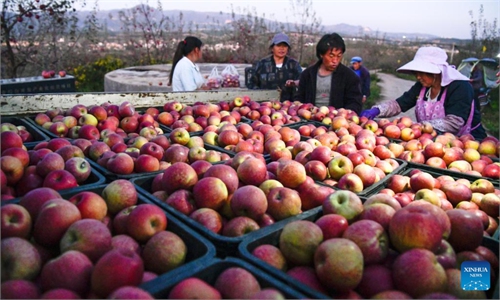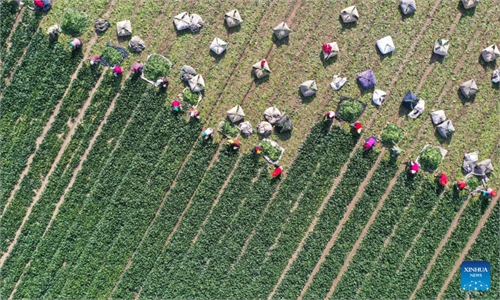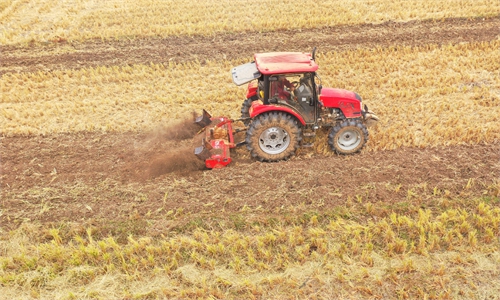Cultivate for another bumper year
China’s sound wintergrain sowing contributes to good harvest in 2023, keeps securing global food supply
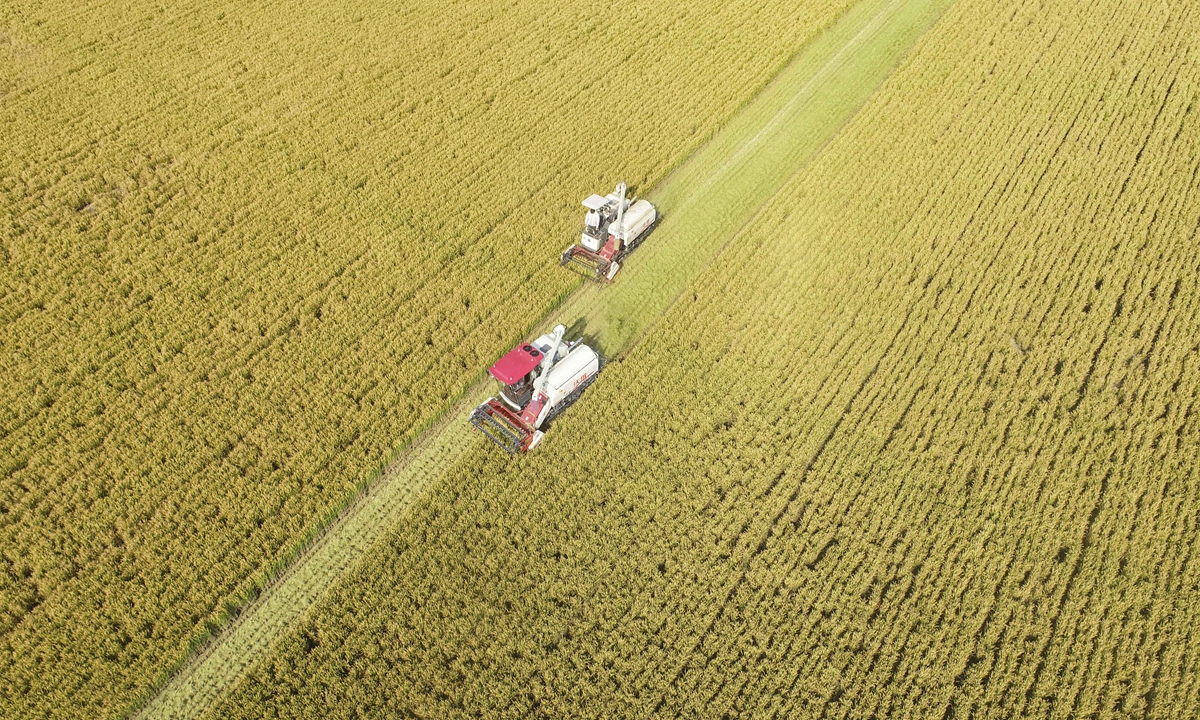
Farmers harvest rice with harvesting machineries in Huai'an, East China's Jiangsu Province. Photo: VCG
With winter grain sowing across China surpassing 99 percent of the total, experts said on Sunday that the smooth sowing this season has laid a solid foundation for next year's harvest, contributing to the global food security while facilitating economic growth despite the downward pressure.With the autumn and winter grain sowing season is drawing to a close, China has completed 99 percent of winter wheat and oilseed rape planting, data from the Ministry of Agriculture and Rural Affairs showed on Saturday.
"We finished sowing by mid-October, generally the same time comparing to previous years," Song Kun, a farmer in Huaibei, East China's Anhui Province, told the Global Times. He planted 20 mu (1.33 hectares) of winter wheat this year.
Anhui is one of the major wheat producing areas of the country. Other main producers include Central China's Henan, Hubei provinces, East China's Shandong Province, as well as North China's Shanxi and Northwest China's Shaanxi Province.
Henan's winter wheat planting area has been maintained around 85 million mu in the year. According to a report by the People's Daily on Friday, more than 11.9 million mu of winter wheat has sprouted in Henan's Zhumadian. Given that there were more weeds in the field this year, farmers and technicians have been using large sprayers to weed so as to ensure the healthy growth of the crops.
Four highlights encapsulate this year's winter grain sowing, including sufficient sowing, high quality seeds, great sprout and better planting structure. With good pricing this year, farmers are motivated to plant more wheat; and the government will further raise the minimum purchase prices for wheat next year, which further stabilizes farmers' expectations for grain yields, China Media Group reported.
This year's winter wheat sprout is the best in recent years, said Lü Xiutao, an official from MOA. Lü noted they will work on stabilizing the wheat planting area above 335 million mu and to strive for a stronger yield growth.
Besides wheat, efforts have been ramped up to expand the plantation of oilseed rape with fallow lands in winter, and it is expected that the planting area will surpass 100 million mu this year.
Food security
"Winter grain is of great significance for ensuring food security, and the smooth sowing of winter grain has laid a solid foundation for the harvest next summer," Li Guoxiang, a research fellow at the Rural Development Institute of the Chinese Academy of Social Sciences, told the Global Times on Sunday.
In spite of frequent extreme weather events and the COVID-19 pandemic in recent years, China has managed to steadily increase grain production, with output stabilizing at 650 million tons for seven consecutive years, and reaching a record of 680 million tons in 2021, according to data from the National Bureau of Statistics.
The steady growth continued in 2022, with the nation's summer grain output hitting 147.4 million tons, a record high, despite challenges like extended autumn flooding, the sporadic resurgence of COVID-19 and rising costs. A bumper autumn harvest is also expected, as 98 percent of autumn grain nationwide has been harvested as of Saturday, according to MOA.
China has firmly grasped the two key elements of agricultural development - strictly adhering to a "red line" of 1.8 billion mu (120 million hectares) of arable land, and accelerating the revitalization of the seed industry, Li said.
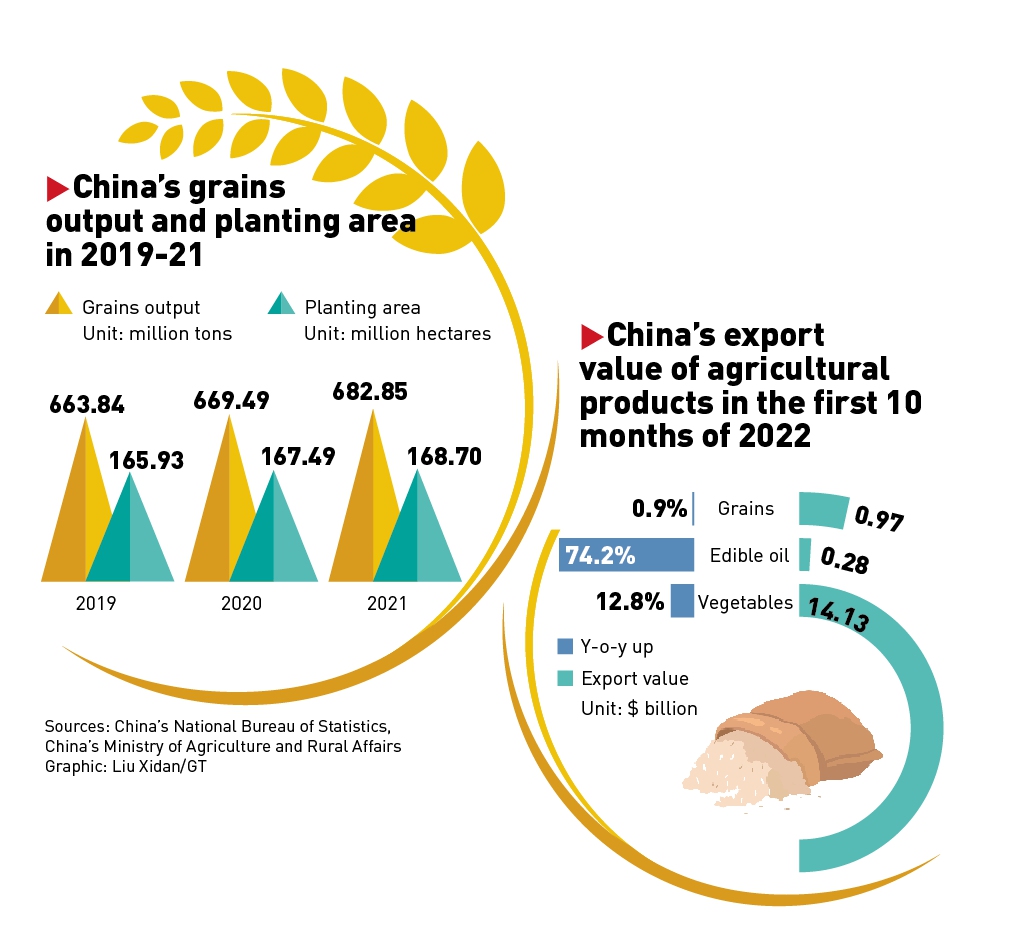
Graphic: Liu Xidan/GT
Against the backdrop of the complicated international landscape exacerbated by the Ukraine crisis, the pandemic and other factors, China's stable grain production is of great significance for the overall food security of the world, Li noted.
The world is on its way to "a raging food catastrophe," UN Secretary-General António Guterres warned at the recent G20 summit in Indonesia. "Without coordinated action, this year's crisis of affordability may become next year's global food shortage," he said.
Though China has only 9 percent of the world's arable land and 6 percent of the freshwater resource, it has been capable of feeding one-fifth of the global population. In addition, China's per capita grain supply hit 483 kilograms in 2021, higher than the internationally recognized safety line of 400 kilograms.
Besides feeding the most populous country in the world, China has been contributing significantly to the global food supply as well. Since the beginning of the year, the nation has provided more than 15,000 tons of emergency humanitarian food aid to developing countries in need.
China's hybrid rice has been introduced to nearly 70 countries and regions on five continents in the world, making outstanding contributions to increasing grain production and agricultural development in those areas, providing China's solution to food shortages.
In the first 10 months of the year, China's export of agricultural products totaled $80.52 billion, surging 20.2 percent year-on-year. The nation exported $970 million worth of grain products, up 0.9 percent; and it exported $280 million worth of edible vegetable oil, surging 74.2 percent, MOA data showed.
Supporting economic growth
The steady growth of grain output does not only secure China's food supply and contribute to the global food security, but also plays a vital role in facilitating the economic recovery and growth amid the mounting downward pressure, Li said.
In the first three quarters of the year, the overall agricultural and rural economy has maintained impressive momentum, with the added value of the primary industry coming in at 5.48 billion yuan, up by 4.2 percent year-on-year. It has provided solid support for ensuring people's livelihoods, holding down inflation and stabilizing the economy, MOA officials said at a quarterly press conference on October 29.
The fixed asset investment in the primary industry recorded 1.06 trillion yuan in the first nine months, up 1.6 percent year-on-year; and the retail sales of rural consumer goods reached 4.26 trillion yuan, up 0.9 percent.
